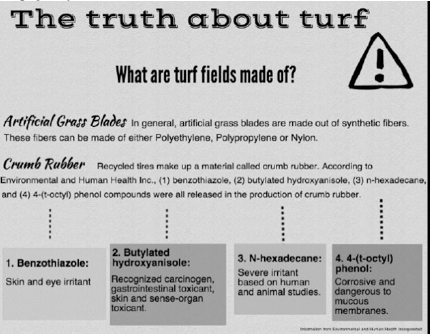Athletes debate the safety of turf fields
What does Jinny Parker field, Staples Stadium and the field at MetLife Stadium all have in common? They’re made of turf, and they might be more dangerous than their grass counterparts.
The turf fields located at Staples are crumb rubber fields, made up of reused, shredded tires. A study conducted by Environment and Human Health, Inc. showed that a chemical contained in this rubber is butylated hydroxyanisole, a recognized carcinogen that is believed to be a toxicant for the endocrine, gastrointestinal, immune and nervous systems. A carcinogen is a substance that is known to directly cause cancer.
According to a recent study conducted by NBC News, the crumb rubber found in turf might not be the safest surface for athletes to play on, and that it may in fact lead to cancer.
Physical education department chair David Gusitsch was not worried by this recent study, or the previous studies about turf fields.
“The administration conducted all the research to make sure there is zero concern for the safety for students, athletes, and anyone else out there on the fields,” Gusitsch said. “I would feel comfortable with my kids out there, participating on those fields.”
However, student athletes felt differently about the situation.
“Athletes usually spend a large part of their lives on the field,” field hockey and lacrosse player Aishah Sofiah ’17 said. “And if [turf] is dangerous for us, we should reevaluate the materials being used.”
The potential that turf fields cause cancer is not the only issue that student-athletes have with these fields. A study conducted by the University of Missouri revealed turf fields are stiffer than the all-grass alternatives, which leads players to injure their knees and ankles more easily. Players also have the risk of getting turf-burns, something they don’t have to deal with when playing on grass.
In the same study, turf fields reached temperatures exceeding 170 degrees Fahrenheit during the summer, presenting a danger to the athletes.
On the other hand, some students feel that it is safer to play on turf. Many grass fields have divots that can either be natural, or caused by overuse of the field without proper maintenance. This can make whatever sport being played more dangerous for the athletes.
“I personally believe turf is safer than grass,” Jonathan Maragos ’16, a football player, said. “Players get better traction versus on grass where it can get really muddy and kids can slide.”
In addition to this, various other studies have shown that turf fields don’t pose a major risk to their users. As shown in a study by the state of California, a chemical found in this rubber, chrysene, increased the probability of cancer by .0000029 percent, only if the rubber is regularly ingested.
Many students weren’t convinced by the studies that cancer could be linked to playing fields on turf.
“I’m not too worried about the turf playing fields. There’s no real definitive studies that show that they can cause cancer,” Lilly Howes ’17, a soccer player, said. “But then again, cell phones and electronic devices cause cancer, and we don’t really care.”
Currently, there are contradicting studies that show that turf can both be safer and more dangerous than their grass equivalents. However, if one of these studies does become available, the school will take whatever precautions necessary to protect its students.
“If there is something serious, [the district] is going to address it,” Gusitsch said. “We’re not going to continue to put people out there, at risk, if there are known facts that show that turf can cause cancer.”

It’s a scorching afternoon in mid-July. The sun, sitting high above, has blanketed everything in an unbearable heat— most of us are lounging out by...

After three years of working on Inklings, Emma Lederer ’16 has found a passion for writing
opinions. “I just have a lot of opinions,” she said...


















































